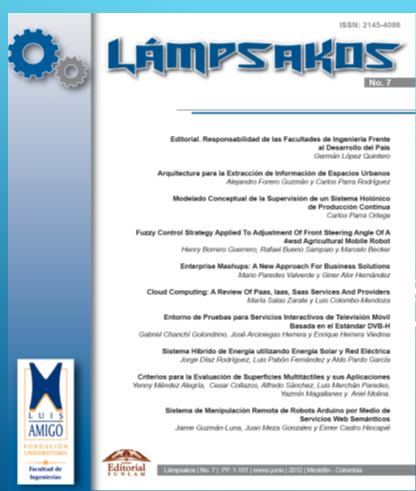Enterprise Mashups: A New Approach for Business Solutions
DOI:
https://doi.org/10.21501/21454086.843Keywords:
Enterprise Mashups, Web applications.Abstract
A mashup is a Web application that integrates content from different providers in order to create a new service which is not offered by the content provider. The development of this kind of applications involves activities such as accessing heterogeneous sources, combining data from different data sources and building graphical interfaces. This factor limits non-experienced computer users to develop these applications. However, nowadays there are enterpriseoriented tools that allow non-experienced user for building mashups in order to respond business needs in an easy and rapid way. Due to this, the enterprise mashup approach has been widely adopted by a large number of enterprises. This paper presents an overview of the enterprise mashup approach, as well as a review of four enterprise-oriented tools which provide a set of features that allows non-expertise users developing mashups into an enterprise. Finally, we present the challenges to be addressed by enterprise-oriented mashup tools in order to provide an easier and faster way of developing mashups.Downloads
References
J. Magazinius, A. Askarov, A. Sabelfeld. “A Lattice-based Approach to Mashup Security”. Proceedings of the 5th ACM Symposium on Information, Computer and Communications Security, pp. 15-23, 2010.
O. Chudnovskyy, H. Gebhardt, F. Weinhold, M. Gaedke. “Business Process Integration using Telco Mashups”. The 8th International Conference on Mobile Web Information Systems, Vol. 3. pp. 677-680, 2011.
J. Soriano, D. Lizcano, M. Cañas, M. Reyes, J. Hierro. “Fostering Innovation in a Mashuporiented Enterprise 2.0 Collaboration Environment”. SIWN International Conference on Adaptive Business Systems, 2007.
Z. Maraikar, A. Lazovik, F. Arbab. “Building Mashups for the Enterprise with SABRE”. Proceedings of the 6th International Conference on Service-Oriented Computing, pp. 70-83, 2008.
J. López, F. Bellas, A. Pan, P. Montoto. “A Component-Based Approach for Engineering Enterprise Mashups”, Lecture Notes in Computer Science, Vol. 5648, pp. 30-44, 2009.
M. Altinel, P. Brown, S. Cline, R. Kartha, E. Louie, V. Markl, L. Mau, Y. Ng, D. Simmen, A. Singh. “Damia: A Data Mashup Fabric for Intranet Applications”. Proceedings of the 33rd international conference on Very large databases, pp. 1370-1373, 2007.
A. Huang, S. Huang, E. Lee, S. Yang, “Improving End-User Programming with Situational Mashups in Web 2.0 Environment”. Proceeding of the 2008 IEEE international Symposium on Service-Oriented System Engineering, pp. 62-67, 2008.
S. Abiteboul, O. Greenshpan, T. Milo, N. Polyzotis, “MatchUp: Autocompletion for Mashups”. Proceedings of the VLDB Endowment, Vol. 2 pp. 538-549, August 2009.
V. Hoyer, K. Stanoevska-Slabeva. “Towards a Reference Model or Grassroots Enterprise Mashup Environments”. Proceedings of the 17th European Conference on Information Systems, 2009.
L- Xu, P. Vrieze, K. Phalp, S. Jeary, P. Liang. “Lightweight Process Modeling for Virtual Enterprise Process Collaboration”. 11th IFIP Working Conference on Virtual Enterprises, pp. 501-508, October, 2010.
P. Vrieze, L. Xu, A. Bouguettaya, J. Yang, & J. Chen. “Process-oriented Enterprise Mashups”. Proceedings of the 2009 Workshops at the Grid and Pervasive Computing Conference, pp. 64- 71, 2009.
V. Hoyer, K. Stanoevska-Slabeva, “Design Principles of Enterprise Mashups”. Proceedings of the 5th Conference of Professional Knowledge Management, 2009.
A. MacAfee. “Enterprise 2.0 The Dawn of Emergent Collaboration”, MIT Sloan Managemente Review, April 2006. [14] Apatar, Retrieved from: http://apatar.com/, 2011.
IBM Mashup Center, Retrieved from http://www- 01.ibm.com/software/info/mashup-center/, 2011. [16] JackBe, Retrieved from: http://www.jackbe. com/, 2011. [17] WaveMaker, Retrieved
Downloads
Published
How to Cite
Issue
Section
License
In accordance with national and international copyrights, as well as publishing policies of "Fundación Universitaria Luis Amigó" and its Journal "Lámpsakos" (indexed with ISSN : 2145-4086), I (we ) hereby manifest:1. The desire to participate as writers and submit to the rules established by the magazine publishers.
2. The commitment not to withdraw the manuscript until the journal finishes the editing process of the ongoing issue.
3. That article is original and unpublished and has not been nominated or submitted together in another magazine; therefore, the rights of the article in evaluation have not been assigned in advance and they do not weigh any lien or limitation for use.
4. The absence of conflict of interest with commercial institution or association of any kind
5. The incorporation of the quotes and references from other authors, tending to avoid plagiarism. Accordingly, the author affirms that the paper being published do not violate copyright, intellectual property or privacy rights of third parties. Morover, if necessary there is a way of demonstrating the respective permits original copyright to the aspects or elements taken from other documents such as texts of more than 500 words, tables, graphs, among others. In the event of any claim or action by a third party regarding copyright on the article, the author (s) will assume full responsibility and come out in defense of the rights herein assigned. Therefore, for all purposes, the Journal "Lámpsakos" of the "Fundación Universitaria Luis Amigó" acts as a third party in good faith.
6. In the event of the publication of the article, the authors free of charge and on an exclusive basis the integrity of the economic rights and the right to print, reprint and reproduction in any form and medium, without any limitation as to territory is concerned, in favor of the Journal "Lámpsakos" of the "Fundación Universitaria Luis Amigó".








